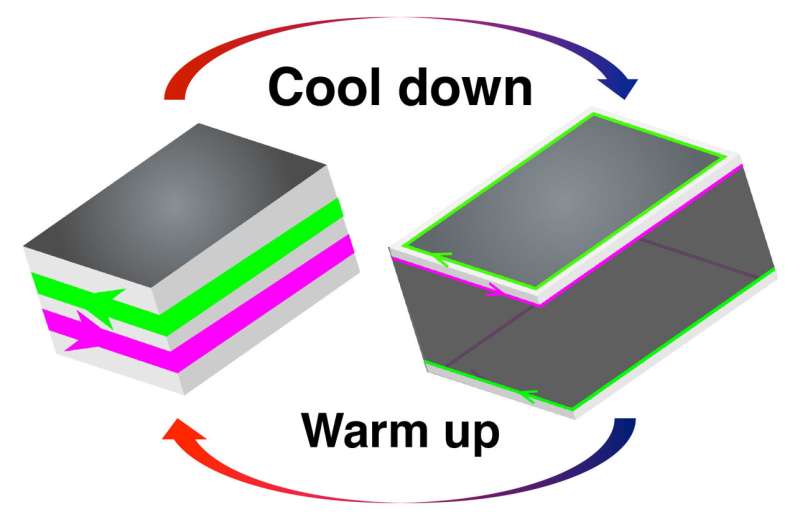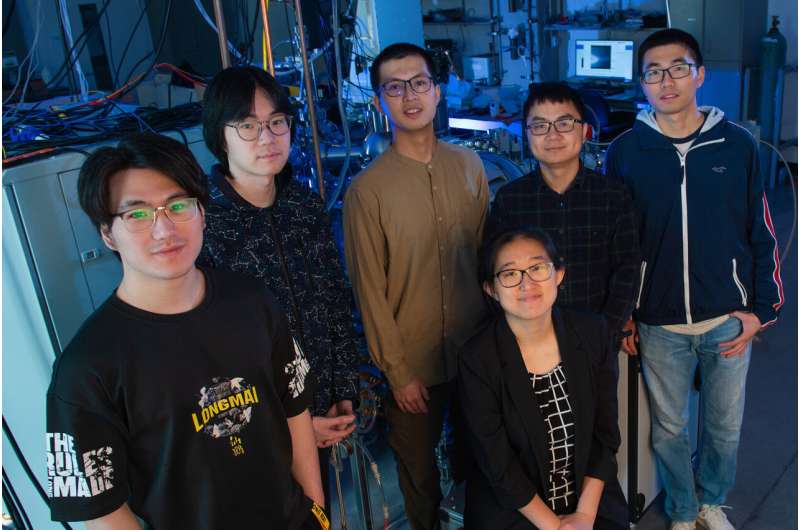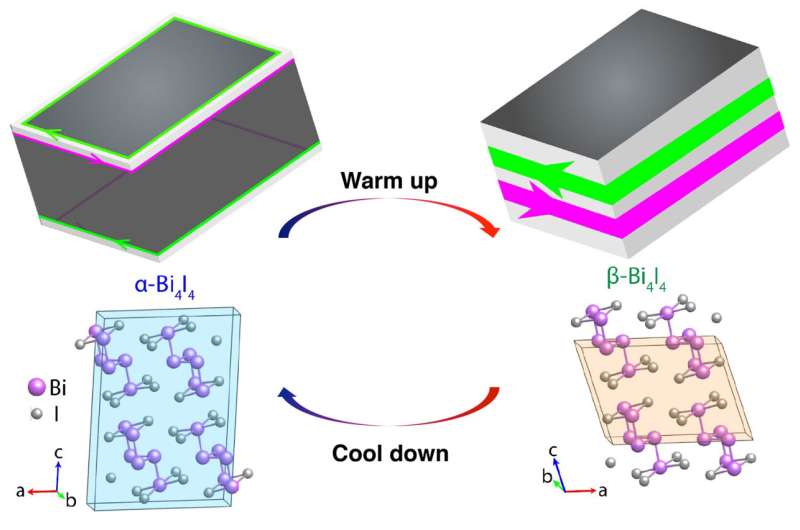Physicists find room-temperature, 2D-to-1D topological transition

A Rice University team and its collaborators have discovered a room-temperature transition between 1D and 2D electrical conduction states in topological crystals of bismuth and iodine.
Researchers found they could toggle the material, crystalline chains of bismuth iodide (Bi4I4), between low- and high-order conduction states at a transition temperature around 80 degrees Fahrenheit. The research is available online this week in the American Physical Society journal Physical Review X and was conducted by physicists from Rice; the University of Texas at Dallas; the University of California, Berkeley; Ohio State University; and other institutions.
Bi4I4 is a topological insulator, a material that's conductive on its surface or edges but not its interior. The crystal lattice of Bi4I4 undergoes a subtle shift at the transition temperature. The shift changes the material's electronic behavior, and the study showed this change, or "phase transition," is the boundary between 1D and 2D topological conduction states.
The high-temperature 2D state features electrical conduction around four sides of the rectangular crystals. Rice physicists Ming Yi, Jianwei Huang and their collaborators discovered conduction transitioned to 1D edges as the material was cooled below 80 degrees.
"This is the first evidence suggesting that the low-temperature state is actually a higher order topological insulator where conduction is happening on the crystal hinges as opposed to the surfaces," said Yi, an assistant professor of physics and astronomy and co-corresponding author of the PRX study. "Imagine starting in the high-temperature state, where you have an insulating bulk and conduction surfaces around the sides of the material. As soon as you go through this structural distortion, the conduction is confined to the one-dimensional hinges where these sides meet."

In most materials, the differences between phases—like solid ice or liquid water—arise from different organizational symmetries of their constituent parts. In the 1980s, physicists discovered phases of matter with identical symmetries. These were eventually shown to arise from topological properties, "protected" quantum states that are of growing interest for quantum computation.
Yi said the dimensional change in electrical conduction mediated by Bi4I4's phase transition could potentially be used for engineering an electrical switch operated by changing temperature.
"This transition happens at room temperature," Yi said. "It's a first-order phase transition, which means the change happens very suddenly. It's a tiny shift of the crystal lattice that directly impacts the electrical conduction on the crystal boundaries."
Huang, a Rice postdoctoral research associate and the study's lead author, said labs worldwide are racing to find and catalog topological materials, and physicists have only recently begun classifying them into subfamilies.
While Bi4I4's combination of properties is unique, Huang said this week's discovery could aid the search for similar topological materials.

"Our findings are consistent with recent theoretical predictions of higher-order topological insulators that are beyond the scope of the established topological materials databases," he said.
Yi's lab and collaborators in the lab of UC Berkeley co-corresponding author Robert Birgeneau used an experimental technique called angle-resolved photoemission spectroscopy (ARPES) to map Bi4I4's electronic band features.
"ARPES is the best probe for looking at topological materials because there's a very distinct signature that will tell if materials are topological or not," she said.
To distinguish between the 1D and 2D conduction states, her team had "to look at different surfaces, and that is extremely difficult to do," Yi said.
Yi said critical contributions came from UT Dallas co-corresponding authors Fan Zhang, who provided theoretical guidance and prediction, and Bing Lv, whose lab synthesized Bi4I4 crystals that were as much as a centimeter long, a millimeter wide and hundreds of microns thick. The size of the crystals allowed Huang to make crucial ARPES measurements on both the tops and sides of the materials.
More information: Jianwei Huang et al, Room-Temperature Topological Phase Transition in Quasi-One-Dimensional Material Bi4I4, Physical Review X (2021). DOI: 10.1103/PhysRevx.11.031042
Journal information: Physical Review X
Provided by Rice University





















